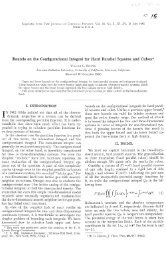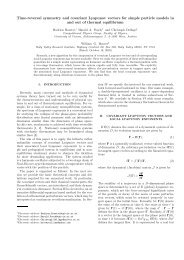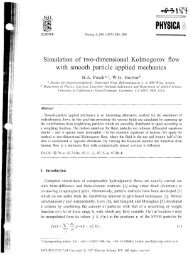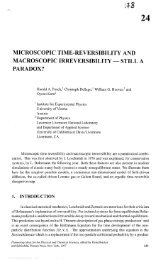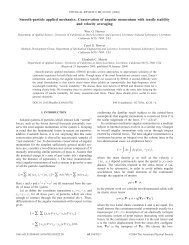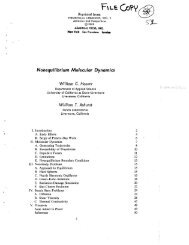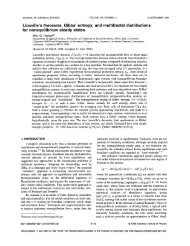Chaos and irreversibility in simple model systems - William Hoover's
Chaos and irreversibility in simple model systems - William Hoover's
Chaos and irreversibility in simple model systems - William Hoover's
You also want an ePaper? Increase the reach of your titles
YUMPU automatically turns print PDFs into web optimized ePapers that Google loves.
CHAOS VOLUME 8. NUMBER 2 JUNE 1998<br />
<strong>Chaos</strong> <strong>and</strong> <strong>irreversibility</strong> <strong>in</strong> <strong>simple</strong> <strong>model</strong> <strong>systems</strong><br />
Wm. G. Hoover<br />
Department of Applied Science, University of California at Davis/Livermore <strong>and</strong> Lawrence Livermore <br />
National Laboratol)', Livermore, California 94551-7808 <br />
Harald A. Posch<br />
Institute for Experimental Physics, University<br />
Vienna, Boltzmanngasse 5, Vienna A·1090, Austria<br />
(Received 24 November 1997; accepted for publication 27 February 1998)<br />
The multifractal l<strong>in</strong>k between chaotic time-reversible mechanics <strong>and</strong> thennodynamic <strong>irreversibility</strong> <br />
is illustrated for three <strong>simple</strong> chaotic <strong>model</strong> <strong>systems</strong>: the Baker Map, the Galton Board, <strong>and</strong> <br />
many-body color conductivity. By scal<strong>in</strong>g time, or the momenta, or the driv<strong>in</strong>g forces, it can be <br />
shown that the dissipative nature of the three thennostated <strong>model</strong> <strong>systems</strong> has analogs <strong>in</strong> <br />
conservative Hamiltonian <strong>and</strong> Lagrangian mechanics. L<strong>in</strong>ks between the microscopic <br />
nonequilibrium Lyapunov spectra <strong>and</strong> macroscopic thennodynamic dissipation are also po<strong>in</strong>ted out. <br />
© 1998 American Institute of Physics. [S1054-1500(98)01l02-1] <br />
Atomistic simulations of macroscopic irreversible pro tion functions could be accumulated, by time averag<strong>in</strong>g, but<br />
cesses require a generalization of the usual Newtonian were no longer the fundamental <strong>in</strong>gredient for theoretical<br />
mechanics. One approach <strong>in</strong>corporates non equilibrium underst<strong>and</strong><strong>in</strong>g. By 1972 nonequilibriu.m many-body simulaconstra<strong>in</strong>ts<br />
<strong>in</strong>to the equations of motion. An alternative tions had suggested a new path to underst<strong>and</strong><strong>in</strong>g<br />
approach couples a Newtonian system to one or more <strong>irreversibility</strong>,z,3 <strong>and</strong> presently led to the discovery of multiheat<br />
reservoirs. Both atomistic approaches lead to fractal fractal phase-space structures, <strong>in</strong> 1986. 4 ,5 Now, 100 years<br />
descriptions quite unlike Gibbs' cont<strong>in</strong>uous probability after Boltzmann, simulations with 10 7 particles are feasible. 6<br />
densities. The fractals reflect the rarity of non equilibrium Recent conceptual advances, result<strong>in</strong>g from few-body<br />
states relative to the equilibrium ones. We illustrate the <strong>and</strong> many-body simulations, were discussed here <strong>in</strong> Budapformation<br />
of such fractal structures for a series of <strong>simple</strong> est. <strong>in</strong> 1997. The new multi fractal structures, which provide<br />
<strong>model</strong>s. In order of <strong>in</strong>creas<strong>in</strong>g complexity-<strong>and</strong> an explanation for <strong>irreversibility</strong>, followed from three <strong>in</strong>derealism-these<br />
are (i) a mapp<strong>in</strong>g of the unit square onto pendent theoretical approaches, discussed here <strong>in</strong> the lectures<br />
itself, (ii) the one-body dynamics of a particle driven by Dorfman <strong>and</strong> Gaspard. All three are tied closely to the<br />
through an array of fixed scatterers by an external field, solution of chaotic nonl<strong>in</strong>ear problems us<strong>in</strong>g traditional clas<strong>and</strong><br />
(iii) the many-body dynamics of a fluid with a field sical mechanics. Assimilation of this explanation <strong>and</strong> underdriv<strong>in</strong>g<br />
half the particles to the right <strong>and</strong> half to the left. st<strong>and</strong><strong>in</strong>g has been delayed, for about ten years, by a disparity<br />
The two last dynamical <strong>model</strong>s illustrate that the fractal <strong>in</strong> viewpo<strong>in</strong>t. For those that view computers as tools for<br />
structures characteriz<strong>in</strong>g constra<strong>in</strong>ed <strong>systems</strong> have ana simulation <strong>and</strong> numerical solution, it is natural to stress<br />
logs describ<strong>in</strong>g driven <strong>systems</strong>. The many-body fluid ex trajectory-based dynamics as fundamental. Boltzmann <strong>and</strong><br />
hibits macroscopic chaotic modes, analogous to hydrody Gibbs' statistical heritage suggests <strong>in</strong>stead that a statistical<br />
namic modes, associated with the <strong>in</strong>dividual <strong>in</strong>stabilities distribution-based dynamics could be considered fundamendescribed<br />
by the Lyapunov exponents.<br />
tal. In addition to this dichotomy, to which we return later,<br />
there is also a po<strong>in</strong>t of view that the puzzl<strong>in</strong>g aspects of<br />
I. INTRODUCTION<br />
<strong>irreversibility</strong> are solely due to the chosen <strong>in</strong>itial conditions. 7<br />
<strong>Chaos</strong> seems to us to have made this last po<strong>in</strong>t of view out<br />
The subject of this meet<strong>in</strong>g at Eotvos University, dated.<br />
"<strong>Chaos</strong> <strong>and</strong> Ineversibility," emphasizes the l<strong>in</strong>k between The multifractal structures generated by dynamical nontime-reversible,<br />
chaotic microscopic mechanics <strong>and</strong> irrevers equilibrium many-body simulations describe what is often<br />
ible macroscopic dissipation. The ma<strong>in</strong> idea is to exam<strong>in</strong>e called the "natural measure" of the dynamics, a record of<br />
the basic pr<strong>in</strong>ciples underly<strong>in</strong>g the simulation <strong>and</strong> analysis of the relative probabilities of visit<strong>in</strong>g neighborhoods of parthennodynamic<br />
<strong>and</strong> hydrodynamic processes. This subject ticular state po<strong>in</strong>ts. Such a measure can be represented by<br />
was popularized by Boltzmann, as described <strong>in</strong> the lecture by po<strong>in</strong>t sets of coord<strong>in</strong>ates {q(ndt)}, which could be further<br />
E. G. D. Cohen. Boltzmann's explanation of macroscopic idealized as def<strong>in</strong><strong>in</strong>g cont<strong>in</strong>uous differentiable trajectories<br />
<strong>in</strong>eversibility, <strong>in</strong> isolated dilute gases, was statistical, based {q(t)}. Alternatively, the same trajectories could be given a<br />
on the one-particle distribution function.<br />
phase-space representation: {q(t),p(t)}. So as to emphasize<br />
Seventy-five years later, at the Livermore <strong>and</strong> Los Ala parallels with Boltzmann's gas theory, <strong>and</strong> Gibbs' statistical<br />
mos laboratories, fast computers opened the door to a revo mechanics, we adopt this last representation. The "multifraclutionary<br />
possibility-the study of irreversible processes tal" character implies that the s<strong>in</strong>gular nature of the po<strong>in</strong>ts'<br />
from detailed dynamical many-body trajectories. l Distribu- density <strong>in</strong> phase space,j(q,p), varies from po<strong>in</strong>t to po<strong>in</strong>t. At<br />
1054-1500/98/8(2)/366/8/$15.00 366 © 1998 American Institute of Physics
<strong>Chaos</strong>, Vo:. 8, No.2, 1998<br />
Wm. G. Hoover <strong>and</strong> H. A. Posch 367<br />
f<br />
r<br />
368 <strong>Chaos</strong>, Vol, 8, r~o, 2, 1998 Wm. G. Hoover <strong>and</strong> H. A. Posch<br />
.. <br />
B <br />
~T T~ <br />
!III<br />
B<br />
(a)<br />
(b)<br />
FIG. 1. Time-reversible dissipative Baker Map. The basic mapp<strong>in</strong>g process "B" stretches without rotation, <strong>and</strong> is shown at the left "TO< <strong>in</strong>dicates<br />
time-reversal, chang<strong>in</strong>g the sign of the vertical coord<strong>in</strong>ate. When the Baker map is applied to the <strong>in</strong>itial po<strong>in</strong>t (0.1,0.1), it generates the attractor shown at the<br />
right. Of the 100000 po<strong>in</strong>ts shown, 66490 lie <strong>in</strong> the largest of the self-similar regions. Us<strong>in</strong>g the first 10 000 000 po<strong>in</strong>ts gave 6 666 340 po<strong>in</strong>ts <strong>in</strong> this region,<br />
<strong>in</strong> good agreement with the "r<strong>and</strong>om" expe.ctation, 2N!3.<br />
while the probability of undergo<strong>in</strong>g twofold compression<br />
[with local exponents In(3/2) <strong>and</strong> In(1I3)] is 2/3, the timeaveraged<br />
exponents are<br />
Al (1/3)ln(27/4), A2 (1/3)ln(2/27).<br />
The Kaplan-Yorke dimension of the attractor shown <strong>in</strong> Fig.<br />
1, the dimension of an object which neither grows nor<br />
shr<strong>in</strong>ks <strong>in</strong> the long term, is also the <strong>in</strong>formation dimension: 14<br />
DKY=D[= 1+(A]/IA 2 1)= 1.734.<br />
The paradoxical qualities of a time-reversible strange attractor<br />
are present here. The long-term change <strong>in</strong> a small comovlng<br />
phase volume ®, follow<strong>in</strong>g the "motion" through N<br />
iterations, is negative, approach<strong>in</strong>g zero as the iteration number<br />
N <strong>in</strong>creases:<br />
(®NI®o!<br />
(II (®,.I®n I))<br />
=eN(AI H 2J=(2/1)NI3 X (112)2,"113.<br />
Likewise paradoxically, the probability density <strong>in</strong>creases toward<br />
<strong>in</strong>f<strong>in</strong>ity, on average,<br />
(/N1fo)=\ II (/nlfn-I))<br />
e -N(;"'I +;"'2)= (2/1)2NI3 X (1/2),"1/3.<br />
This odd behavior is generic for nonequilibrium timereversible<br />
stationary states. 4 ,15 "Stationary" is a euphemism<br />
for time-<strong>in</strong>dependent, <strong>and</strong> refers to the motion equations <strong>and</strong><br />
the imposed boundary conditions, both are here def<strong>in</strong>ed by<br />
the map.<br />
We stress that stationarity is a property of the dynamics,<br />
rather than the solution, because the form of the solution<br />
cont<strong>in</strong>ually changes, show<strong>in</strong>g more <strong>and</strong> more detail with iteration,<br />
on f<strong>in</strong>er <strong>and</strong> f<strong>in</strong>er scales, IX t -lI2, as the time t<br />
progresses <strong>and</strong> more data are generated, From the mathematical<br />
po<strong>in</strong>t of view, repellors <strong>and</strong> attractors are limit<strong>in</strong>g<br />
stationary sets, for <strong>in</strong>f<strong>in</strong>itely long sampl<strong>in</strong>g times. From the<br />
computational po<strong>in</strong>t of view, any numerical approximation<br />
to these structures cont<strong>in</strong>ues to develop <strong>in</strong> time, <strong>and</strong> never<br />
achieves stationarity. Though both the repeUor <strong>and</strong> the attractor<br />
have negligible measure <strong>in</strong> thc usual sense, be<strong>in</strong>g<br />
fractal objects with dimensionality 1.734 <strong>in</strong> this illustrative<br />
case, the flow condenses onto the attractor with probability<br />
one. This <strong>simple</strong> condensation process, onto a zero-volume<br />
fractal set, is the microscopic mechanical analog of the second<br />
law of thermodynamics. 4 ,15 Although fluctuations can<br />
occur (correspond<strong>in</strong>g toa run of phase-volume <strong>in</strong>creases,<br />
with correspond<strong>in</strong>g decreases <strong>in</strong> f) it is obvious that, eventually,<br />
the second law (correspond<strong>in</strong>g to overall volume deerease<br />
<strong>and</strong> the divergence of f) must be satisfied. No other<br />
stationary time-development can be consistent with a<br />
bounded phase volume.<br />
It might be thought that the f<strong>in</strong>ite precision, typically<br />
eight figures, of computer simulations would spoil the generality<br />
of the conclusions. But simulations us<strong>in</strong>g double or<br />
quadruple precision <strong>in</strong>dicate that there is no noticeable effect<br />
of <strong>in</strong>creased accuracy. In this connection Levesque <strong>and</strong> Verlet<br />
have shown how to generate a perfectly reversible equilibrium<br />
dynamics by us<strong>in</strong>g <strong>in</strong>teger coord<strong>in</strong>ates. 16 ,17 It has<br />
been stated that a "coarse-gra<strong>in</strong><strong>in</strong>g" is essential to an underd<br />
mg ' 0 f noneqUl 'l'b 1 num . d ynamlCS. . 18,19 Th at IS, . t h e deve<br />
stan I
<strong>Chaos</strong>, Vol, 8, No, 2, 1998<br />
E<br />
e <br />
ee ~<br />
_e_ <br />
eeee <br />
eeeee <br />
FIG, 2, Galton Board, An abridged 15-scatterer portion of the structure is<br />
shown at the left. The full Galton Board can be represented computationally<br />
by the reduced dynamics with<strong>in</strong> a s<strong>in</strong>gle cell, as is shown at the right. The<br />
angles a <strong>and</strong> f3 describe the location <strong>and</strong> post-collision velocity direction,<br />
for each scatter<strong>in</strong>g,<br />
op<strong>in</strong>g multifractal structure of the phase-space density must<br />
be ignored, below some usually unspecified scale. As Tel has<br />
emphasized, there are advantages <strong>in</strong> ignor<strong>in</strong>g the <strong>in</strong>exorable<br />
change of "steady-state" distributions. These <strong>in</strong>clude the<br />
underst<strong>and</strong><strong>in</strong>g of entropy derivatives <strong>and</strong> l<strong>in</strong>ks with Fokker<br />
Planck equations, But to us "coarse-gra<strong>in</strong><strong>in</strong>g" appears to be<br />
no more than an arbitrary choice, not a necessity,<br />
Though <strong>simple</strong>, this Baker Map nicely illustrates the<br />
puzzle of <strong>irreversibility</strong>: a time-reversible rule generates a<br />
time series of po<strong>in</strong>ts with irreversible characteristics, a<br />
shr<strong>in</strong>k<strong>in</strong>g phase volume, <strong>and</strong> an ever-<strong>in</strong>creas<strong>in</strong>g probability<br />
density, both for a "stationary" dynamics. A variety of maps<br />
has been <strong>in</strong>troduced <strong>and</strong> studied, though only recently has<br />
the importance of time-reversibility to their relevance been<br />
stressed. 10 Maps can be concatenated <strong>in</strong>to a cha<strong>in</strong>,20,21 replac<strong>in</strong>g<br />
the solitary Baker by a mass-production "Boulangerie."<br />
The system boundaries, at the two ends of such a cha<strong>in</strong>,<br />
can be absorb<strong>in</strong>g, reflect<strong>in</strong>g, or have def<strong>in</strong>ed fluxes, Invariably,<br />
multifractal phase-space structures, obey<strong>in</strong>g the expected<br />
Green-Kubo relations, for near-equilibrium conditions,<br />
result. 22<br />
So far we know of no publications, us<strong>in</strong>g maps, <strong>in</strong> which<br />
the number of degrees of freedom is <strong>in</strong>creased <strong>in</strong> more than<br />
a s<strong>in</strong>gle direction, or <strong>in</strong> which more than a s<strong>in</strong>gle quantity is<br />
conserved (caricatur<strong>in</strong>g mass, momentum, or energy conservation).<br />
But there are many potentially <strong>in</strong>terest<strong>in</strong>g possibilities<br />
along the cont<strong>in</strong>uum separat<strong>in</strong>g the conventional Baker<br />
Map from state-of-the-art f<strong>in</strong>ite-difference or f<strong>in</strong>ite-element<br />
solutions of the cont<strong>in</strong>uum equations. It is still possible that<br />
maps are too <strong>simple</strong> to reveal much about the nonl<strong>in</strong>ear <strong>in</strong>teractions<br />
of many particles. Let us proceed to a one-body<br />
cont<strong>in</strong>uous flow, the Galton Board, which can readily be<br />
extended to the many-body case.<br />
III. TIME-REVERSIBLE DISSIPATIVE GALTON BOARD<br />
In 1873 Sir Francis Galton (1822-1911) used his probability<br />
demonstrator, the orig<strong>in</strong>al "Galton Board," which<br />
generated the b<strong>in</strong>omial <strong>and</strong> Gaussian distributions, by follow<strong>in</strong>g<br />
the progress of an ensemble of mov<strong>in</strong>g particles<br />
through a periodic array of scatterers. 23 This same idea can<br />
be represented computationally as is shown <strong>in</strong> Fig. 2, where<br />
the dynamics of an ensemble, <strong>in</strong> the full Galton Board, can<br />
Wm, G, Hoover <strong>and</strong> H, A, Posch 369<br />
be faithfully represented by the time-averaged motion of a<br />
s<strong>in</strong>gle particle <strong>in</strong> a s<strong>in</strong>gle unit cell. Five different methods<br />
have been used to extract, or to nullify, the <strong>in</strong>fluence of the<br />
k<strong>in</strong>etic energy, ga<strong>in</strong>ed from the field, on the dynamics. Three<br />
<strong>in</strong>volve damp<strong>in</strong>g: (i) from a pervasive viscous fluid,24 (ii)<br />
from <strong>in</strong>elastic scatter<strong>in</strong>g,2S or (iii) from determ<strong>in</strong>istic<br />
thennostats. 9 ,26 Two others have been used, (iv) time scal<strong>in</strong>g<br />
accord<strong>in</strong>g to a specified function of the coord<strong>in</strong>ates or<br />
momenta,27 <strong>and</strong> (v) field scal<strong>in</strong>g. 28 The last three methods<br />
produce isomorphic trajectories. With an exponential dependence<br />
of the field on the particle coord<strong>in</strong>ate, the particle's<br />
potential energy can ma<strong>in</strong>ta<strong>in</strong> a fixed ratio to the k<strong>in</strong>etic<br />
energy, result<strong>in</strong>g <strong>in</strong> a dynamic stationary state, <strong>in</strong> configuration<br />
space, but with an exponentially <strong>in</strong>creas<strong>in</strong>g extension <strong>in</strong><br />
momentum space. All five of the approaches just outl<strong>in</strong>ed<br />
lead to similar fractal phase-space structures, <strong>and</strong> to identical<br />
transport behavior <strong>in</strong> the weak-field limit.<br />
Though they are derived from conservative Hamiltonian<br />
mechanics, the trajectories generated by time-scal<strong>in</strong>g or<br />
field-scal<strong>in</strong>g are isomorphic, mean<strong>in</strong>g "hav<strong>in</strong>g the same<br />
shape," the same dependence of y on x, to those generated<br />
by constant-field thennostated mechanics, "isok<strong>in</strong>etic mechanics,"<br />
<strong>in</strong> which k<strong>in</strong>etic energy is extracted from the mov<strong>in</strong>g<br />
particle by thermostat forces l<strong>in</strong>ear <strong>in</strong> the momentum:<br />
py= F" - t;Py.<br />
Here the forces F describe the <strong>in</strong>teraction of a mov<strong>in</strong>g particle<br />
with a scatterer (a hard disk <strong>in</strong>teraction <strong>in</strong> the <strong>simple</strong>st<br />
case) while E is the external field, driv<strong>in</strong>g the motion <strong>in</strong> the<br />
x direction. The isok<strong>in</strong>etic "friction coefficient" t; is chosen<br />
to make the k<strong>in</strong>etic energy of the mov<strong>in</strong>g particle constant:<br />
In 1986 Bill Moran discovered the multifractal nature of<br />
the Galton Board trajectories as well as the complex nature<br />
of the motion at very high field strengths. 9 Soon it became<br />
clear that the repellor-attractor pair structure, characteristic<br />
of the Board, was shared by most time-reversible nonequilibrium<br />
stationary states. The Galton-Board <strong>model</strong> became a<br />
paradigm for <strong>irreversibility</strong>8 because it is the <strong>simple</strong>st flow to<br />
exhibit all the generic features associated with chaotic <strong>irreversibility</strong>:<br />
(i) time-reversible dynamics, (ii) multifractal<br />
phase-space structure, <strong>in</strong>clud<strong>in</strong>g a repellor-attractor pair, (iii)<br />
ergodicity, <strong>and</strong> (iv) overall dissipation, with the paradoxical<br />
feature that the "stationary" dynamics cont<strong>in</strong>ually shr<strong>in</strong>ks<br />
the comov<strong>in</strong>g phase volume, while cont<strong>in</strong>u<strong>in</strong>g to visit all<br />
po<strong>in</strong>ts <strong>in</strong> the allowed volume.<br />
The <strong>simple</strong> two-dimensional "Po<strong>in</strong>care section" of the<br />
"Galton Board problem" is easy to visualize. This section is<br />
a projection of the motion onto a <strong>simple</strong>r space describ<strong>in</strong>g<br />
the geometry of the collisions. Two sample sections, an attractor<br />
<strong>and</strong> a repellor, both at a relatively strong field, appear<br />
<strong>in</strong>' Fig. 3. So far no three-dimensional cont<strong>in</strong>uous ergodic<br />
flow, free of s<strong>in</strong>gularities <strong>and</strong> periodicities, has been found to<br />
illustrate all these same four features just listed above (reversible<br />
repellor-attractor pair with ergodic dissipation). In<br />
four dimensions, the thermostated oscillator, with control of
370 <strong>Chaos</strong>, Vol. 8, No.2, 1998 Wm. G. Hoover <strong>and</strong> H. A. Posch<br />
FIG. 3. Po<strong>in</strong>care sections, describ<strong>in</strong>g the 200 000 collisions, both forward <strong>in</strong> time, giv<strong>in</strong>g rhe "attractor," shown at the left. <strong>and</strong> backward, giv<strong>in</strong>g the<br />
"repeIlor," shown at the righi, for a field strength of 0"), where iT is the scatlerer diameter. Individual collisions are represented as dots <strong>in</strong> the sec:ion.<br />
The abscissa is the angle O~a~ 11" <strong>and</strong> the ord<strong>in</strong>ate is - 1~s<strong>in</strong>,8~-,-l. See Fig. 2. Note that the repellor is the exact mirror image of the attractor.<br />
both the second moment, through 1;, <strong>and</strong> the fourth moment,<br />
through g, is the <strong>simple</strong>st cont<strong>in</strong>uous example lO which<br />
avoids the complexities of s<strong>in</strong>gularities <strong>and</strong> periodic boundaries:<br />
q=p, p= q I;p_gp3, t=p2 T,<br />
3p2,<br />
If the temperature T is chosen to vary with q, T( q)<br />
+ Etanh(qlh), for <strong>in</strong>stance, then, for reasonable values of E<br />
<strong>and</strong> h, a multifractal ergodic repellor-attractor pair structure<br />
develops <strong>in</strong> the four-dimensional space, In the "equilibrium"<br />
nondissipative case, E= 0, the motion reproduces the<br />
analytic solution of Liouville's flow equation: 29<br />
aflat=o+-+f(q ,p,1;, I;) =<br />
It would be useful to f<strong>in</strong>d a three-dimensional mapp<strong>in</strong>g<br />
analogous to a Po<strong>in</strong>care section of this <strong>simple</strong> set of four<br />
equations.<br />
IV. TIME-REVERSIBLE DISSIPATIVE MANY-BODY<br />
COLOR CONDUCTIVITY<br />
The Galton Board problem is isomorphic to a two-body<br />
periodic problem,30 with one of the two particles, at r with<br />
velocity v. accelerated upward, while the second particle, at<br />
- r with v, is accelerated downward. This two-body problem<br />
generalizes naturally to the two-species many-body<br />
"Color Conductivity" problem <strong>in</strong>dicated <strong>in</strong> 4, with the<br />
field-dependent equations of motion:<br />
{x p,lm, y<br />
Aga<strong>in</strong>, a friction coefficient I; has been chosen to keep the<br />
k<strong>in</strong>etic energy constant.<br />
Figure 4 illustrates color conductivity <strong>in</strong> a form suited to<br />
thermodynamic analysis, The system, NI2 gray particles <strong>and</strong><br />
NI2 black ones, is bathed <strong>in</strong> a heat reservoir, at temperature<br />
T, with such a large heat capacity that the temperature never<br />
varies, The heat reservoir could be further visualized as a<br />
(nearly) ideal gas of (nearly) massless particles collid<strong>in</strong>g<br />
with the system particles <strong>in</strong> such a way as to force a thermal<br />
equilibrium between the thermometer <strong>and</strong> the systeml The<br />
rate at which the system's phase-space volume contracts, accord<strong>in</strong>g<br />
to Liouville's theorem:<br />
d In0ldt= dlnfldt<br />
2. (axlax) + (ajlay)-J (JPxIJpx)<br />
is also identical to the rate at which the external entropy Se<br />
of the pervasive heat reservoir <strong>in</strong>creases,<br />
--d In0ldt=dlnfldt $elk<br />
- l-VlkT= - QlkT.<br />
This relationship holds <strong>in</strong>stantaneously, so that se, "Hr, <strong>and</strong> Q<br />
can have either sign. Because - k(dlnfldt) corresponds also<br />
to the time-rate-of-change of Gibbs' system entropy, which<br />
decreases, on average, some feel it necessary to ignore the<br />
presence of a thermostat <strong>and</strong> to discuss <strong>in</strong>stead "entropy<br />
production," as a property of the system,18.19 To us, this<br />
emphasis on an ill-def<strong>in</strong>ed system entropy, rather than the
<strong>Chaos</strong>, Vol. 8, No.2, 1998<br />
Wm. G. Hoover <strong>and</strong> H. A. Posch<br />
371<br />
0.5 ,-----,------,---,-----,-----, 3.2<br />
0.4<br />
3.1<br />
ISOKINETIC<br />
Eo ___<br />
K<br />
0.3<br />
0.2<br />
0.1<br />
o<br />
K<br />
2.9<br />
L8<br />
o 0.05 0.1 0.15 0.2 0.25<br />
N-l/2<br />
FIG. 5. Number-dependence of the largest Lyapunov exponent, AI, <strong>and</strong><br />
color conductivity, K. for two-dimensional particles with a soft repulsive<br />
potential. The data <strong>in</strong> Ref. 13 suggest deviations of order N- 112 from welldef<strong>in</strong>ed<br />
large-system limit<strong>in</strong>g values.<br />
The three problems outl<strong>in</strong>ed here all illustrate (but do<br />
not expla<strong>in</strong>) the l<strong>in</strong>k between chaotic time-reversible dynamics<br />
<strong>and</strong> irreversible macroscopic behavior. Microstates violat<strong>in</strong>g<br />
the second law of thermodynamics have probability<br />
zero, correspond<strong>in</strong>g to the multifractal nature of the repellor,<br />
while the correspond<strong>in</strong>g, <strong>and</strong> geometrically similar, strangeattractor<br />
states attract the flow. The rate at which phase vol<br />
I<br />
l<br />
ADIABATIC<br />
E(t) --II<br />
FIG. 4. Thermodynamic views of isok<strong>in</strong>etic constant-field <strong>and</strong> adiabatic<br />
scaled-field color conductivity simulations. In both cases the external field<br />
accelerates gray particles toward the right <strong>and</strong> black particles to the left. The<br />
isok<strong>in</strong>etic constant-field simulation <strong>in</strong>corporates a pervasive heat bath. <strong>in</strong>dicated<br />
by diagonal stripes, which keeps the system k<strong>in</strong>etic energy constant.<br />
The simulations are isomorphic, with correspond<strong>in</strong>g pa!1icles <strong>in</strong> the two<br />
system types trac<strong>in</strong>g out identical {.l,y} trajectories, so that the comov<strong>in</strong>g<br />
ratio, In[t(r)/fid'''ll is exactly the same for the two dynamics, where fideal<br />
refers to an ideal gas with the same k<strong>in</strong>etic energy <strong>and</strong> density.<br />
well-def<strong>in</strong>ed entropy of the surround<strong>in</strong>gs, is an arbitrary<br />
choice, not a necessity. On a time-averaged dynamical basis<br />
only the sign consistent with the macroscopic second law of<br />
thermodynamics is also consistent with microscopic dynamical<br />
stability, so that (se/k>o).5<br />
The thermostated dynamics just described has an isomorphic<br />
tw<strong>in</strong>, with exactly the same particle trajectories<br />
{y(x)}, but with adiabatic equations of motion. Dettmann<br />
<strong>and</strong> Morriss have described a variety of ways to construct<br />
correspond<strong>in</strong>g <strong>systems</strong> obey<strong>in</strong>g fully classical, Hamiltonian<br />
<strong>and</strong> Lagrangian mechanics, without thermostats (t= 0).32,33<br />
Choquard described his <strong>in</strong>dependent discovery of some of<br />
these same <strong>systems</strong> <strong>in</strong> his lecture at this meet<strong>in</strong>g. One of the<br />
<strong>simple</strong>st ways is to impose a special time-dependent field<br />
ECt). For f<strong>in</strong>ite N it is necessary that the field <strong>in</strong>crease <strong>in</strong><br />
strict proportion to the k<strong>in</strong>etic energy, E(t)/Eo=KCt)/Ko. In<br />
the large-system limit, which computer simulations <strong>in</strong>dicate<br />
is well-behaved, with both f<strong>in</strong>ite conductivity <strong>and</strong> f<strong>in</strong>ite<br />
Lyapunov exponents,13 this scal<strong>in</strong>g takes on a particularly<br />
<strong>simple</strong> form for hard disks or hard spheresY<br />
E(t)=Eo/[l-(tlT)]",<br />
where the characteristic time T corresponds to the time required<br />
for the orig<strong>in</strong>al field, Eo, to dissipate an energy of<br />
order NkTo. Similar approaches can be constructed for the<br />
study of viscous flows <strong>and</strong> heat flowsY It should be stressed<br />
that these isomorphisms are not at all limited to the l<strong>in</strong>ear-<br />
response Green-Kubo regime. The fully nonl<strong>in</strong>ear, but thermostated,<br />
response has an exact analog, multi fractal structures<br />
<strong>and</strong> alL <strong>in</strong> classical mechanics, without. thermostats.<br />
In this problem, as well as s<strong>in</strong>gle-species analogs for the<br />
shear <strong>and</strong> bulk viscosities, <strong>and</strong> heat conductivity, the weakfield<br />
transport coefficient can be shown to reproduce exactly<br />
the Gibbs-ensemble predictions of l<strong>in</strong>ear-response theory. It<br />
appears that the color conductivity, K == (± v / E), depends<br />
smoothly on system size, extrapolat<strong>in</strong>g to a well def<strong>in</strong>ed, but<br />
field-dependent limit, as the number of particles is <strong>in</strong>creased.<br />
See Fig. S.<br />
A similar result holds for the largest Lyapunov exponent<br />
AI, which is a measure of the long-time tendency for two<br />
nearby trajectories to separate:<br />
\ (d/dr)lnL Oq2) == \ (d/dt)lnL Op2)<br />
==\ (d/dt)lnL (oq2+ OP2))<br />
== 2A l'<br />
For exponential separation, the coord<strong>in</strong>ate-space,<br />
momentum-space, <strong>and</strong> phase-space descriptions all give the<br />
same Lyapunov exponent. See Fig. S. The exponential separation<br />
rate which characterizes "Lyapunov <strong>in</strong>stability," has<br />
some <strong>in</strong>terest<strong>in</strong>g l<strong>in</strong>ks to macroscopic physics. The largest<br />
components of the vector separat<strong>in</strong>g the two trajectories lie<br />
ma<strong>in</strong>ly <strong>in</strong> a subspace of contiguous particles, as is shown <strong>in</strong><br />
Fig. 6. A macroscopic explanation for these <strong>simple</strong> structures,<br />
reported on for the first time here, is still miss<strong>in</strong>g.<br />
V. DISCUSSION, EMPHASIZING FUTURE<br />
DEVELOPMENTS
372 <strong>Chaos</strong>, Vol. 8, No, 2, 1998 Wm, G. Hoover <strong>and</strong> H, A, I"oscn<br />
FIG. 6, Typical modes associated with the two largest Lyapunov exponents, A" shown at the left, <strong>and</strong> 1. 1 , shown at the right, <strong>in</strong> a color conductivity<br />
simulation with 102400 particles, In the somewhat more-localized mode, at the left, about 1500 particles, with squared offset vectors of 10- 6 or more, are<br />
emphasized. N<strong>in</strong>e of these particles have contributions exceed<strong>in</strong>g 10- 2 In the second-largest mode, shown to the right, the largest squared offset vector is<br />
6<br />
about 10- 3 Altogether abollt 1900 particles make contributions greater than 10 . Though the figure illustrates the vectors <strong>in</strong> configuration space, the<br />
correspond<strong>in</strong>g vectors <strong>in</strong> momentum space, or <strong>in</strong> phase space, look very similar.<br />
ume collapses to the attractor is exactly equivalent to the rate<br />
of external entropy <strong>in</strong>crease <strong>and</strong> to the rate of Gibbs' entropy<br />
decrease, se Ik -'~G'bbJk dln0ldt.<br />
The multifractal structure is the key to underst<strong>and</strong><strong>in</strong>g the<br />
coexistence of time reversibility <strong>and</strong> macroscopic irreversible<br />
dissipation. It is not at all accidental that the same k<strong>in</strong>d<br />
of fractal structures appear <strong>in</strong> the <strong>simple</strong> cha<strong>in</strong>s of maps studied<br />
by Breymann, Gaspard, Tasaki, Tel, <strong>and</strong> Vollmer <strong>and</strong><br />
found to give identical l<strong>in</strong>ear-response conductivities for a<br />
variety of boundary conditions. These <strong>model</strong>s have an <strong>in</strong>terest<strong>in</strong>g<br />
connection to Fokker-Planck equations. 34 Multifractal<br />
phase-space objects are also found <strong>in</strong> the "Eseape-Rate"<br />
formalism of Gaspard <strong>and</strong> Nicolis,35 where the fractals then<br />
reflect the rarity of equilibrium states constra<strong>in</strong>ed to mimic<br />
particular nonequilibrium constra<strong>in</strong>ts, but with strietly<br />
Hamiltonian mechanics.<br />
The focus at Budapest, "<strong>Chaos</strong> <strong>and</strong> Irreversibility,"<br />
clearly revealed two complementary descriptions of nonequilibrium<br />
<strong>systems</strong>: dynamic trajectories, obey<strong>in</strong>g ord<strong>in</strong>ary differential<br />
equations, or evolv<strong>in</strong>g phase-space distributions,<br />
obey<strong>in</strong>g partial differential equations. The dynamic approach<br />
seems to us much <strong>simple</strong>r, <strong>in</strong> many ways. It corresponds<br />
more closely to laboratory experiments, to practical simulation<br />
techniques, <strong>and</strong> its mathematics is <strong>simple</strong>r. It should not<br />
be discounted that the fractal structures which complicate a<br />
phase-space distribution-function analysis were actually discovered<br />
as time series generated by a <strong>simple</strong> dynamics. The<br />
"irreversible entropy production" of the distributionfunction<br />
approach, as formulated by its adherents, is identical<br />
to the external entropy <strong>in</strong>crease of a heat reservoir (see<br />
aga<strong>in</strong> Fig. 4) <strong>in</strong> <strong>in</strong>teraction with a s<strong>in</strong>gle dynamical system. It<br />
appears that the two approaches are <strong>in</strong> full agreement, at<br />
least <strong>in</strong>sofar as l<strong>in</strong>ear irreversible thermodynamics is concemed.<br />
Any further advances, toward underst<strong>and</strong><strong>in</strong>g truly<br />
nonl<strong>in</strong>ear processes, await further results from dynamics, not<br />
from ensemble theory,<br />
It is particularly <strong>in</strong>terest<strong>in</strong>g that diffusive, viscous, <strong>and</strong><br />
conduct<strong>in</strong>g flows can be simulated with both non<br />
Hamiltonian <strong>and</strong> Hamiltonian, or Lagrangian, equations of<br />
motion, with exactly isomorphic trajectories. 27 It is possible<br />
to show that the fraction of the available space occupied by<br />
the attractor is the same <strong>in</strong> both cases. In the thermostated<br />
case phase volume shr<strong>in</strong>ks, relative to the total, as time<br />
passes. tn the Hamiltonian <strong>and</strong> Lagrangian eases the driven<br />
system heats up, <strong>and</strong> the constant phase volume occupies a<br />
decl<strong>in</strong><strong>in</strong>g fraction of the <strong>in</strong>creas<strong>in</strong>g "accessible" phase<br />
space.<br />
Some of those who <strong>in</strong>itially doubted the fractal explanation<br />
of the l<strong>in</strong>k between chaos <strong>and</strong> <strong>irreversibility</strong> 15,36 have by<br />
now constructed their own conv<strong>in</strong>c<strong>in</strong>g examples,37 which<br />
should quell the concems of the unconv<strong>in</strong>ced. In less than a<br />
generation, Boltzmann's orig<strong>in</strong>al explanation of the l<strong>in</strong>k between<br />
chaos <strong>and</strong> <strong>irreversibility</strong>, limited as it was, has been<br />
generalized to apply to a wide range of <strong>systems</strong>, stationary<br />
<strong>and</strong> periodic, dense <strong>and</strong> dilute, fluid <strong>and</strong> solid.<br />
Computer simulations of shear flows 38 show that nonl<strong>in</strong>ear<br />
effects are typically very small. Even <strong>in</strong> the strongest<br />
shock waves 39 the effects due to nonl<strong>in</strong>earity are no more<br />
than 30%. Nevertheless, there rema<strong>in</strong>s a need to leave the<br />
sponse theory <strong>and</strong> the results of l<strong>in</strong>ear irreversible<br />
I<br />
thermodynamics. 40 ,4J Shock waves, with their strongly non- !<br />
I l<br />
naive <strong>model</strong>s beh<strong>in</strong>d, to go beyond Green-Kubo l<strong>in</strong>ear ref<br />
I
<strong>Chaos</strong>, Vol. 8, No.2, 1998<br />
Wm. G. Hoover <strong>and</strong> H. A. Posch 373<br />
equilibrium structures enclosed by equilibrium boundary<br />
conditions, are probably the <strong>simple</strong>st choice. Nonequilibrium<br />
phase transitions likewise call for the study of a transition<br />
region ma<strong>in</strong>ta<strong>in</strong>ed by boundary fluxes. Both problems are<br />
well with<strong>in</strong> current computational abilities. A study of noise,<br />
as seen <strong>in</strong> dynamical simulations, should prove fruitful <strong>in</strong><br />
provid<strong>in</strong>g <strong>in</strong>creased underst<strong>and</strong><strong>in</strong>g of the difference between<br />
the microscopic <strong>and</strong> macroscopic descriptions of nonequilibrium<br />
processes l9 Likewise, there is a possibility that efforts<br />
to improve upon the predictions of the Central Limit<br />
Theorem 42 will payoff, giv<strong>in</strong>g estimates of nonequilibrium<br />
fluctuations far from equilibrium. Though it is difficult to<br />
design fully classical experiments, the challenge of devis<strong>in</strong>g<br />
experimental confirmations of the complex multifractal<br />
structures found with simulations, <strong>and</strong> with theoretical analyses,<br />
rema<strong>in</strong>s.<br />
ACKNOWLEDGMENTS<br />
We have discussed reversibility with a number of colleagues,<br />
<strong>and</strong> have profited particularly from recent conversations<br />
with Aurel Bulgac, Christoph Dellago, Carl Dettmann,<br />
Denis Evans, Brad Holian, Carol Hoover, Dimitri Kusnezov,<br />
Joel Lebowitz, Michel Mareschal, Gregoire Nicolis, <strong>and</strong><br />
Tamas Tel. The novel eigenvector plots appear<strong>in</strong>g <strong>in</strong> Fig. 6<br />
were generated with the help of Kev<strong>in</strong> Boercker. 13 Work at<br />
the Lawrence Livermore National Laboratory was performed<br />
under the auspices of the University of California, through<br />
Department of Energy Contract W-7405-eng-48. Work at the<br />
University of Vienna was supported by the Fonds zur<br />
Forderung der wissenschaftlichen Forschung, Grant Pl1428<br />
PHY.<br />
I B. 1. Alder <strong>and</strong> T. E. Wa<strong>in</strong>wright, Sci. Am. 201, 113 (1959).<br />
2 A. W. Lees <strong>and</strong> S. F. Edwards, J. Phys. C 5, 1921 (1972).<br />
3W. T. Ashurst <strong>and</strong> W. G. Hoover, Phys. Rev. Leu. 31, 206 (1973); Phys.<br />
Rev. A 11,658 (1975).<br />
4B. L. Holian, W. G. Hoover, <strong>and</strong> H. A. Posch, Phys. Rev. Lett. 59, 10<br />
(1987).<br />
5W, G. Hoover, H. A. Posch, B. L. Holian, M. J. Gillan, M. v1areschal, <strong>and</strong><br />
C. M. Massobrio, Mol. Simul. 1, 79 (I987).<br />
6B. L. Holian, P. S. Lomdahl, <strong>and</strong> S. J. Zhou, Physica A 240, 340 (1997).<br />
7 J. Bricmon!, Phys. Mag. 17, 159 (1995); see Sec. 3.<br />
8N. l. Chernov, G. L. Ey<strong>in</strong>k, 1. L. Lebowitz, <strong>and</strong> Y. G. S<strong>in</strong>ai, Phys. Rev.<br />
Lett. 70, 2209 (1993).<br />
9B. Moran, W. G. Hoover, <strong>and</strong> S. Bestiale, 1. Stat. Phys. 48, 709 (1987).<br />
IOWm. G. Hoover, O. Kum, <strong>and</strong> H. A. Posch, Phys. Rev. E 53, 2123 (1996).<br />
II W. G. Hoover, C. G. Tull, <strong>and</strong> H. A. Posch, Phys. Lett. A 131, 211 (1988).<br />
12H. A. Posch, Ch. Dellago, W. G. Hoover, <strong>and</strong> O. Kum, <strong>in</strong> Pioneer<strong>in</strong>g<br />
Ideas for the Physical <strong>and</strong> Chemical Sciences, edited by W. Fleischhacker<br />
<strong>and</strong> T. Schonfeld (Plenum, New York, 1997), pp. 233-248.<br />
13W G. Hoover, K. Boercker, <strong>and</strong> H. A. Posch, Phys. Rev. E 57, 3911<br />
D. Fanner, E. Ott, <strong>and</strong> 1. A. Yorke, Physica D 7, 153 (1983).<br />
15 See the discussions <strong>in</strong> Microscopic Simulations of Complex HydmdyrWlnic<br />
Phenomena, edited by M. Mareschal <strong>and</strong> B. L. Holian, Vol. 292,<br />
NATO ASI Series <strong>in</strong> Physics (Plenum, New York, 1992).<br />
JOD. Levesque <strong>and</strong> L. Verlet, J. Stat. Phys. 72, 519 (1993).<br />
17<br />
0. Kum <strong>and</strong> W. G. Hoover, 1. Stat. Phys. 76, 1075 (1994). <br />
18p. Gaspard. 1. Stat. Phys. 88, 1215 (1997). <br />
19G. Nicolis <strong>and</strong> D. Daems, J. Phys. Chem. 100, 19187 (1996). <br />
20 S. Tasaki <strong>and</strong> P. Gaspard, 1. Stat. Phys. 81, 935 (1995). <br />
211. Vollmer, T. Tel, <strong>and</strong> W. Breymann, Phys. Rev. Lett. 79, 2759 (1997). <br />
22W. Breymann, T. Tel, <strong>and</strong> J. Vollmer, Phys. Rev. Lett. 77, 2945 (1996). <br />
K. Pearson, The Life, Leiters <strong>and</strong> Labours of Francis Galton, Vol. III<br />
(Cambridge University Press, Cambridge, Engl<strong>and</strong>, 1930).<br />
24W. G. Hoover <strong>and</strong> B. Moran, <strong>Chaos</strong> 2, 599 (992)<br />
25 A. Lue <strong>and</strong> H. Brenner, Phys. Rev. E 47,3128 (1993) .•<br />
26W. G. Hoover <strong>and</strong> B. Moran, Phys_ Rev. A 40, 5319 (1989).<br />
27Wm. G. Hoover, Phys. Leu. A 235,357 (1997).<br />
28W. G. Hoover, B. Moran, C. G. Hoover, <strong>and</strong> W. J. Evans, Phys. Lett. A<br />
133, 114 (J 988).<br />
291. Andrey, Phys. Lett. A 111,45 (1985); 114, 183 (986). <br />
30 A. 1. C. Ladd <strong>and</strong> W. G. Hoover, I. Stat. Phys. 38, 973 (1985). <br />
31W. G. Hoover, B. 1. Holian, <strong>and</strong> H. A. Posch. Phys. Rev. E 48,3196 <br />
(1993).<br />
32c. P. Dettmann <strong>and</strong> G. P. Morriss, Phys. Rev. E 54, 2495 (1996).<br />
33C. P. Detunann <strong>and</strong> G. P. Morriss, Phys. Rev. E 55, 3693 (1997).<br />
34T. Tel, J. Vollmer, <strong>and</strong> W. Breymann, Europhys. Lett. 35, 659 (1996).<br />
35p. Gaspard <strong>and</strong> G. Nicolis, Phys. Rev. Lett. 65, 1693 (1990).<br />
36M. Marescha1, Adv. Chem. Phys. 100,317 (1997).<br />
37N.L Chernov <strong>and</strong> J. 1. Lebowitz, Phys. Rev. Lett. 75, 2831 (1995).<br />
3SS. Y. Liem, D. Brown, <strong>and</strong> J. H. R. Clarke, Phys. Rev. A 45, 3706 (1992).<br />
39B. L. Holian, W. G. Hoover, B. Moran, <strong>and</strong> G. K. Straub, Phys. Rev. A<br />
22,2798 (1980).<br />
40W. G. Hoover, Computational Statistical Mechanics (Elsevier. Amsterdam,<br />
1991).<br />
41 D. 1. Evans <strong>and</strong> G. P. Morriss, Statistical Mechanics of Nonequilibrium<br />
Liquids (Academic, New York, 1990).<br />
42D.1. Evans, E. G, D. Cohen, <strong>and</strong> G. P. Morriss, Phys. Rev. Lett. 71, 2401<br />
(1993).



